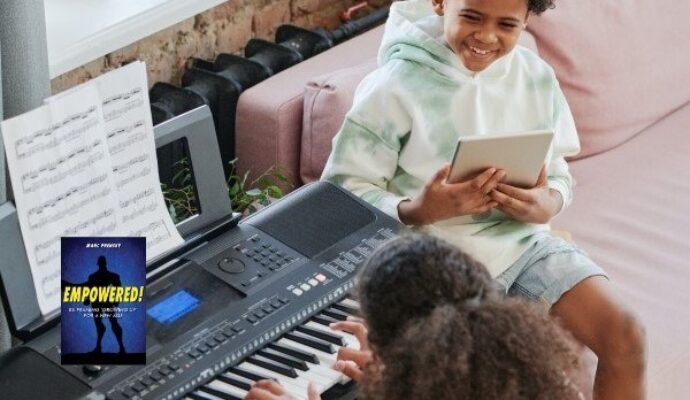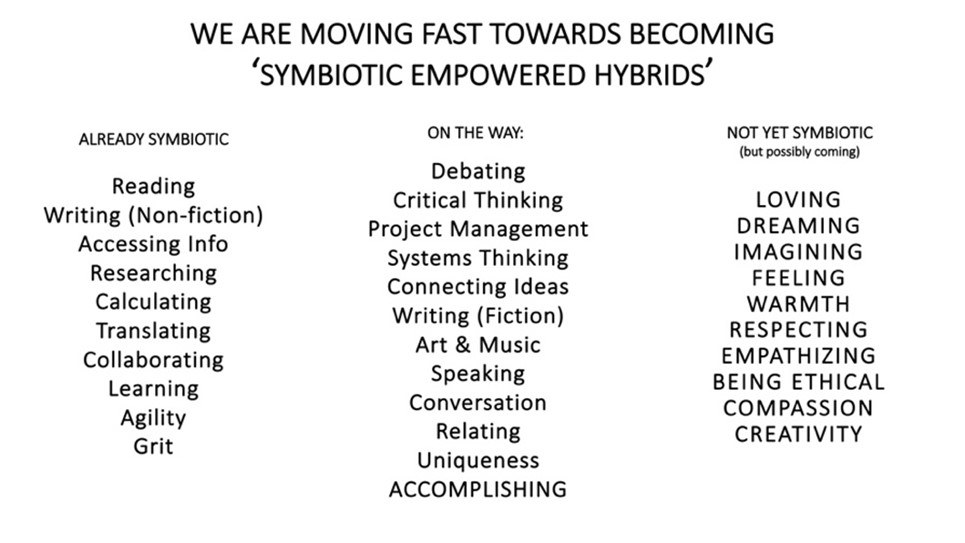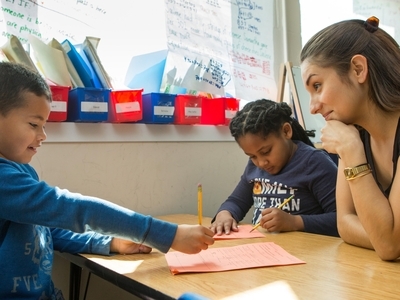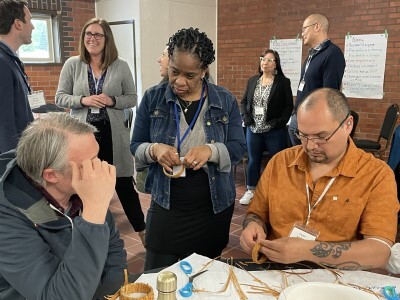Re-Framing Who Young People Are, Part 2
Topics

Next generation learning is all about everyone in the system—from students through teachers to policymakers—taking charge of their own learning, development, and work. That doesn’t happen by forcing change through mandates and compliance. It happens by creating the environment and the equity of opportunity for everyone in the system to do their best possible work.
EMPOWERED! Chapter 4
Seeing a more symbiotic relationship with technology allows young people to use it more positively and productively, empowering them in ways never experienced by prior generations.
Note: This article is a reprint of the second half of “Chapter 4: Re-Framing Who Young People Are” of the author’s book, EMPOWERED! Re-framing ‘Growing Up’ for a New Age. You may want to start by reading the first part of Chapter 4.
A More Useful Frame
A far more useful re-frame for technology is to see it not as an addictive substance or behavior, but more like humans having evolved a new body part. People with the technology now have something that is always with them that seriously extends their capabilities. It’s very much like having a new limb, with new fingers that can reach out around the globe to places you want to be.
Because the technology—this new human body part—is so new, we have hardly mastered its use. One’s real hand can be used both positively—to feed, caress, and pet—and also negatively—to punch, slap, and take what’s not yours. But when young people do those undesirable things, parents and teachers don’t cut young people’s hands off. (Some once did, perhaps, but now that’s considered barbaric.) What they now do instead is they help the young people use their body parts more positively and productively. From the young people’s point of view it is barbaric to take away their technology because they live in a new world—a world of symbiotic humans—where these things are a part of them.
For Whose Good?
Adults will claim, of course, they are taking the technology away “for the kids’ own good.” But what they usually mean is that it’s for the good of the adults. It’s the adults—and not the kids—who enjoy their dinner more when the kids are not staring at their phones. Often, what the adults are really trying to do is to keep an old culture going—i.e., to bring the kids back to the times and behaviors they (i.e., the adults) thought were better.
New Humans
But what if the young people don’t think they are better? Smart phones didn’t exist (in their current form) in the 20th century, when all adults grew up. Many of those same adults were told by their own parents to turn off their rock music. As far as we know, the rock music didn’t do them any harm.
It didn’t particularly help those young people either—it certainly didn’t turn them into a new kind of human. But that is precisely what these new appendages are doing to our young people—turning them into a new kind of human—and in a very positive way. Today’s young people can connect constantly to friends anywhere, to information they need, and to many forms of satisfaction. Already many kids now go most of their early life with earbuds and music constantly in their ears. Their technology is becoming new parts of them, in a similar way to pacemakers, artificial heart valves, or cochlear implants. Soon many more new technologies will move inside their bodies just as medical tools have already done. Screens, and even hand-held devices, will likely have been just an interim step to a more tightly-integrated symbiosis. What 21st-century young person wouldn’t want that?
Different Things at Different Speeds
But it’s not all happening at once. Look at this chart, and its three columns.

Column 1: “Already Symbiotic”
The left-hand column consists of tasks where a great many of us are already symbiotic with technology. Although the means of the past still do exist to do the things in that column, few serious, 21st-century people would do any of these things without incorporating technology in some form (if they have it)—just as very few would make a sign by carving it in stone. Some still do these things in the old way, but a growing number now read only on their smartphones, or through their ears, do all their research online, and use their calculator for everything arithmetical.
That is because everything in the left-hand column can already be done faster and better by incorporating technology—in many cases the technology already in your pocket (assuming, of course, the technology has reached you.) Despite being born in earlier times, I already do all the things in that column on my smartphone —and consider myself better off because of it. My 16-year-old son does even more. By the time they are adults, it is likely (and it should be our goal) that every young person born today in the world will have a connected device—today’s smartphone or a better equivalent—with which to do these things.
Note that even for “grit” or “stick-to-it-iveness”—qualities much sought after by parents—we are often much better off assigning our technology parts of the task to do (and using it to remind us to do our own parts) than trying to do it all ourselves. The machine parts never forget, get tired, or get bored—as humans often do.
Column 2: “Well on Their Way”
In addition to those listed in the first column, symbiosis is fast becoming the norm for a great many more human tasks—such as those in the middle column. Everything in that column is fast approaching a symbiotic state—i.e., the point at which doing them with technology is so much more powerful than without it that it makes little sense not to. For debating, check out IBM’s Project Debater on You Tube. It shows a Watson computer constructing and presenting an entire formal debate side, including opening statement, rebuttals, and conclusions. The computer, by itself, almost wins. In symbiosis with a human, it is the very best way.
I would particularly call your attention to art and music in this middle list. I personally got to watch the earliest beginnings of this still birthing symbiosis between art and technology as many guitar players—including Bob Dylan—switched from acoustic to primarily electric instruments. Today a great many young artists and musicians are in the process of becoming one with their new technology tools—moving far beyond the musical instrument and media tools of the past. There are now a great many interactive music and art performances and exhibitions where the technology lets the audience participate directly in the creative process—new kinds of art for the New Age of Empowerment.
Consider also “relating” and “accomplishing.” Some young people already hone their conversation skills, in multiple languages, with A.I. chatbots like Siri. Old people in Japan and other places are using robots for companionship. People who are shy and/or autistic often communicate more easily and comfortably through technology. In sum, it is becoming harder and harder to accomplish anything new and different in the world without the use of some sort of technology. It helps us; we help it. That is called “symbiosis.”
Column 3: Coming Faster Than We Think
The activities in the right-hand column are often considered to be deeply “human.” Many will opine that technology has not yet made many inroads there, and some would say it never will.
But that is not entirely true.
Although technology doesn’t yet give us hugs and kisses, we can already have warm, loving conversations at a distance using technologies like Zoom or even the telephone. (We could do this for a long while with writing, but not in real time.) I believe technology now allows humans to maintain more and far better warm and loving relationships at long distances. In our young people’s lifetimes, technology will almost certainly be available to help us be more compassionate, empathetic, and even, I believe, ethical (for example, by monitoring our behavior and offering suggestions).
So, while we may think of these “third column” things as more human and less symbiotic for the moment, that moment is unlikely to last long. Everything on the chart will, I predict, soon involve technology, in some symbiotically integrated way, for many or most people. I highly recommend you, the reader, start re-framing yourself and your children as “Symbiotic Human Hybrids.”
| Harbingers |
| Harbingers of the coming of Symbiotic Empowered Hybrids include every young person with a mobile phone who refuses to part with it just because an adult tells them they should. More advanced harbingers are the thousands of young people around the world who already have created real, world-improving, projects using technology symbiosis, such as the 15-year-old boy who invented a sandal for women in rural India to wear that captures the energy of her steps and gives her a loud alarm to sound if she is attacked, or the 13 year-old girl who created an app that identifies loved ones for Alzheimer’s patients. |
| Reflection Questions |
| Can YOU see young people in this new, “hybrid” way? What do you think are the implications? |
Read More: EMPOWERED!
- Chapter 1: Re-Framing Growing Up for a New Generation, Part 1 and Part 2
- Chapter 2: A New Generation Seeing Things in a New Way, Part 1 and Part 2
- Chapter 3: Re-Framing Our Young People’s Times, Part 1 and Part 2
- Chapter 4: Re-Framing Who Young People Are, Part 1
- Chapter 5: Re-Framing Where Young People Will Live, Part 1 and Part 2
- Chapter 6: Re-Framing What Young People Believe, Part 1 and Part 2
The full book is available on Amazon.
Photo at top by Boris Pavlikovsky.




